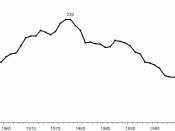"Low-income working families have always been the least insulated from market forces. When the economy sneezes, they get pneumonia." Bernstein and Lazere (2001) make this statement to point out that when our economy is struggling, our poor are in the worse trouble (p. 1). The working poor in America face many challenges not only during economic struggle, but during every occasion. Sherman (1999) explains that the level of poverty is high today partly because of economic aspects such as sluggish earnings and the increasing gap between rich and poor (p.2). It's obvious that the government and the economy play a vital role in the poverty level of the U.S.
Thirteen million children, as stated by Sherman (1999), lived below the poverty in 1998. This number is higher than any other Western Nation (p.1). Even though the U.S encounters a high poverty rate, Sherman further explains that government policies for overcoming poverty are "poorly designed" (p.2).
Bernstein and Lazere (2001) explain that the newer program, Temporary Assistance for Needy Families (TANF), which replaced Aid to Families with Dependent Children, often rejects families that need the assistance. Also 540,000 families that were on TANF have been removed from the program because they could not follow the rules set before them (p. 2)
Welfare reform, as Koch (2000) points out, has not made matters much better. Two years before the reform 2.4 million children had risen out of poverty. But the 2 years after the reform only 360,000 children had crept out of the state (p. 4). Hill (1998) stated that the American welfare system is hurting the lower middle class. He further explains that the people in this group who do have skills will succeed, but the majority, those without skills will be in poverty for their entire lives (p. 3).



America's Poor
You make some good points but you need to add a bibliography at the end of your essay.
5 out of 5 people found this comment useful.